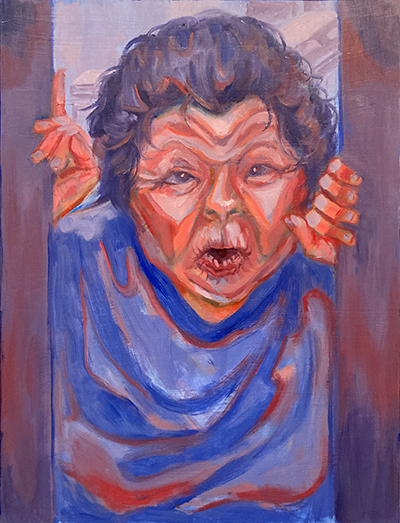At the Minneapolis Institute of Art, teen art students are hosting a conversation around racism, health care inequities, and their own experiences and identities in an art exhibit that is both deeply personal and provocative.
The program is organized in partnership with Blue Cross and Blue Shield of Minnesota, and brings high school students from high schools in Minneapolis and St. Paul, plus Perpich Arts High School in Golden Valley to work with teaching artists to address racism through their artistic practice.
Bukata Hayes, vice president of racial and health equity and chief equity officer at BCBSM, says the program came about after the foundation declared racism a public health crisis, and needed to address that.
“I think we also acknowledged that we would have to partner in new ways and utilize multiple avenues to bring about awareness, and to bring about action,” Hayes says to me in a phone interview. Key to the program was centering voices of young people who have been historically marginalized as they used art to amplify messages about racial health inequities and how we can move forward, Hayes adds.
Earlier in May, Mia held an opening event for an exhibition, “Teen Perspectives on Race and Health Equity,” made of the art the young people created in the program, which will be on view through Aug. 27. The young artists show paintings, mixed media pieces, drawings, digital work, photography and sculpture, exploring topics like health inequities in maternal health, medical malpractice and abuse towards women of color, and more. “I was struck by how aware these young people are about this issue– not only in their lives, but in the lives of folks they know,” Hayes tells me, after attending the opening event.
“Powerful, creative pieces that these high school students were able to produce gives, in some ways, reassurance that they see the issues and are willing and want to be part of the solution to those issues,” Hayes says.
Ebony Beck was an educator in the program, and a lot of her work was keeping the space safe and inviting in the program. That part was easy. “They were all so aware,” she tells me at the opening event, “I didn’t need to do much, which was awesome.”
Through the program, Beck also gave advice to the young people on structure and value in their art piece, and helped them talk through the process and brainstorm. “That was a lot of fun,” she says.
In the work, Beck didn’t want to dig too personally into the young people’s personal experiences with health. “There are layers of comfort there,” she says. “But I did want to open it up, so if they did feel comfortable, that wouldn’t be a negative experience for them.”
Interviewed near her art piece, Shawntea Kopseng, a student at Minnesota Transitions Charter School (MTS), created a piece based on her birth mother, who had seven children.

Kopseng is adopted and never met her birth mother, who died two years ago from an overdose. In the piece, Kopseng depicts a woman whose face is partially covered with hair. She wears a feather, and a shawl, and holds an expression of depression as light from the windows shines through blinds.
“The expression that she has is a sad expression,” Kopseng remarks. “And since I never got to meet my mother, it was very hard to think of her in such distress.”
The piece came out of discussions she had in the program about health disparities in maternal health. “It was really nice to hear from other people and their experiences with racism and health problems,” she says.

Pasi Lee, a student at Perpich Center for Arts Education, also depicted a family member in her piece exhibited at Mia. Her painting of her grandmother during the isolation of COVID is haunting. The older woman seems to be peering through a window, or a doorway, and has an expression of desperation. It’s a haunting piece that captures a feeling of Lee’s grandmother being closed in.
“During those years of COVID and also before COVID, she was very sick, and she had to be hospitalized for half a year,” Lee says. “It was a very long time, especially for her because she has a big fear of hospitals. That’s kind of common with my other older relatives as well.” Lee’s family is Hmong, and has a history of mistrust of the health system in the U.S. That barrier to health was a topic Lee wanted to explore in her piece.
Other artists have pieces that explore identity. Lucía Samayoa incorporated her Guatemalan heritage in “Dios no es destino,” a mixed media work that layers in photographs, maps, painting, and a poem called “Salud Mental” by Vianney Harelly, one of Samayoa’s favorite authors.
“She wrote this poetry book about generational trauma and struggles with being the daughter of immigrants,” Samoyoa says. “It really inspired me to make this piece.”
Robert (RJ) Smith’s digital arts teacher at MTS, suggested Smith participate in the program. It was the first time he dealt with issues around race in his artwork.

“Teen Perspectives on Race and Health Equity” is on view at the Minneapolis Institute of Art through August 27.


0 Commentaires